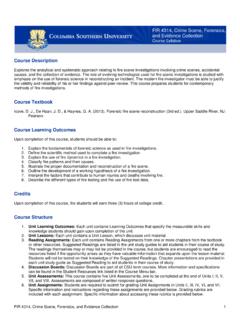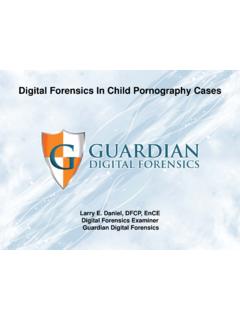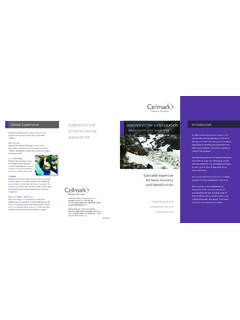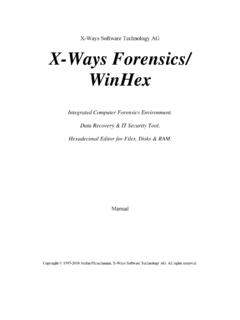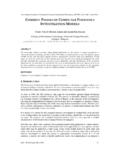Transcription of Computer Forensics - ISFS Homepage
1 Computer ForensicsPart 1: An Introduction to Computer ForensicsInformation Security and Forensics Society (ISFS) 2004 AnIntroduction to Computer ForensicsInformation Security and Forensics Society2 OverviewThis document is designed to give non-technical readers an overview of Computer Forensics . It is not intended to offer legal advice of anykind. Specificallythe following questions are is Computer Forensics ? individuals and organizations need to payattention to Computer Forensics ? is digital data? knowledge of Computer Forensics so important? does a Computer Forensics specialist do? should a companydo if an incident occurs?AnIntroduction to Computer Forensics Information Security and Forensics Society31. What is Computer Forensics ? Computer Forensicsis the science of obtaining, preserving, and documenting evidencefrom digitalelectronic storage devices, such as computers, PDAs, digital cameras, mobile phones, and various memorystorage devices.
2 All must be done in a manner designed to preserve the probative value of the evidence and to assure its admissibilityin a legal can think of it as the science of Forensics applied in a digital environment. But where a traditional Forensics specialist might collect and preserve fingerprints or other physical evidence, the Computer Forensics specialist collects and preserves digital evidence. This collection of digital evidence must be done through carefully prescribed and recognized procedures so that the probative value of digital evidence is preserved to ensure its admissibilityin a legal traditional Forensics mayinvolve people with different specialties, Computer Forensics similarly involves a multitude of professional specialties working together to gather, preserve and analyze digital evidence. Computer Forensics vs.
3 Computer SecurityThough Computer Forensics is often associated with Computer Security,the two are different. Computer Forensics is primarilyconcerned with the proper acquisition, preservation and analysis of digital evidence, typically after an unauthorized access or use has taken place. With Computer Security the main focus concerns the prevention of unauthorized access, as well as the maintenance of confidentiality, integrityand availabilityof Computer , Computer Securityand Computer Forensics are complimentaryin that greater familiarity with Computer Forensics may lead to greater awareness of the importance of both Computer security, in general, and proper procedural controls governing theaccess and use of computers, networks and other devices. Furthermore, in the event of a breach of security, a great deal maybe learned during the process of collecting digital data.
4 This knowledge can be applied to improve system procedural controls, operations and staff capabilities. 1 StevenM. Abrams and Philip C. Weis, Knowledge Of Computer Forensics Is Becoming Essential For Attorneys In The Information Age , New York State Bar JournalFebruary, to Computer ForensicsInformation Security and Forensics Society42. Whydo individuals and organizations need to payattention to Computer Forensics ?Nowadays, more and more people are using computers and devices with computing capability. For example, onecan send and receive e-mail messages from handheld devices (such as mobile phones, or PDAs), participate in online Computer gamessimultaneously with other game playersover digital networks, or manage their finances over the , manybusiness and personal transactions are conducted electronically: Business professionals regularlynegotiate deals bye-mail; People store their personal address books and calendars on desktop computers or PDAs.
5 People regularlyuse the Internet for business and pleasureAccording to a University of California study, 93% of all information generated during 1999 was generated in digital form, on computers; only 7%of information originated in other media, such as paper2. Moreover, a significant percentage of Computer -created documents might never be printed on paper. Manymessages and documents are exchanged over the Internet and are read on the Computer screen but are not printed Preservation of EvidenceAs computers, computing devices (or other devices with computing capabilitysuch as mobile phones or PDAs) and networks become more widely used in general, the chance that crimes involving such networks and devices occur will goes without saying that in order to prosecute such crimes, evidence must first be gathered both: in sufficient quantityto substantiate anycriminal or civil charges, and handled properly so that the evidence will hold upin as much of this evidence will be in digital form the ability to extract the relevant digital evidence in a manner that preserves the value and integrity of the datais critical.
6 This is the reason we need a careful, methodical process for gathering digital data in the first place; andthis is whywe need Computer Whydo we need Computer Forensics ?Consider a hypothetical scenario where a criminal has broken into an organization s premises and stolen critical assets (money, data or reports). A responsible executive would have no hesitation in calling in profession Forensics examiners and extending them all necessarycooperation. Such cooperation might involve cordoning off the crime scene to ensure that: The area is not disturbed, Evidence is not accidentallycontaminated or tampered with, Forensics professionals have access to the necessaryinformation or locations. 2 MaryKayBrown and , Digital Dangers: A Primer On Electronic Evidence In The Wake Of Enron , Pennsylvania Bar Association Quarterly January, to Computer Forensics Information Security and Forensics Society5 The executive would do this because it is in thebest interest of his or her organization because relevant evidence must be collected, the more the better, if the criminal is to be caught, assets are to be recovered or if court action is to be successful.
7 Without this evidence, anychances of asset recoveryor successful court prosecution will , this evidence must be collected and preserved in a proven, systematic manner to ensure admissibilityin court. Now, let s suppose the criminal had committed the theft electronically --for example he hacked into an organization's computers to steal valuable data such as strategic business plans, secret formulae, customer data, account number or employee records. Or perhaps, the criminal is an insider committing a white-collar crime or fraud using the organization s computers. A responsible executive similarlywould know that it was in his or her best interest to call in the appropriate Computer Forensicsspecialists and extend them as much cooperative assistance as possible because if thereis to be anychance of recovering property, locating and successfully prosecuting the criminal, there must be evidence of sufficient quantityand with a physical crime scene, digital evidence must also be carefullyand systematicallycollected and preserved to ensure admissibility in court.
8 The locations where digital evidence might be found for example, Computer hard drives or digital media should not be disturbed to minimize the chance of losing valuable evidence. Computer Forensics professionals should be extended the requisite cooperation and have access to the necessaryinformation or handling digital evidence differs in manywaysfrom handling physical evidence and an investigator must know: Where to look for digital evidence The proper wayto acquire this evidence How to handle and preserve this evidence in such a manner that preserves its probative valueTo appreciate whydigital evidence requires specialized management, we must first understand the nature of digital to Computer ForensicsInformation Security and Forensics Society63. What is Digital Data and where can it be found?Understanding the nature of digital data involves knowing what types of digital data exist and where these data can be Types of DataA modern Computer typically stores vast amounts of data.
9 Some of these data are active others maybe residual or back up Active DataActive data consists of user created data such as customer information, inventorydata, word processing documents or spreadsheets, program and operating system files, including and other MetadataManyusers are aware of the important data kept within data files. However, manyusers may not be aware of the other information about the files including the time of creation and the person creating it that mayalso be useful in an investigation. This data is referred to as example, were one to open a Microsoft Word document and check properties (byclicking on File then Properties in the top menu) one would find a wealth of information including the dates and times document was created, last modified and printed, the number of revisions, file size and editing metadata, which is stored within the document itself, can contain the historyof the document, including all users who have modified and/or saved it, the directorystructure of all machines it was saved on and names of printers it was printed on.
10 Operating System dataData from the Computer s operating system can be a rich source of details about what a user has been doing. From this data, a Forensics specialist mayretrieve information such as Web sites a user has visited; e-mail messages sent and received, accessing the Internet, browsers keep records of the sites a user has visited. If a user permits cookies, which are small files used bybrowsers to keep track of, among other things, a user's visits, cookies maybe a valuable source of information about the user's Internet practices storing all sorts of data including passwords. These records can be retrieved byforensics investigations if clear evidence of sites the user has visited is Temporary FilesWhen a user runs a program, for example a word processor, data maybe temporarilystored on the hard drive. For instance, Microsoft Word saves changes to a document at set intervals in a separate, temporaryrecovery file when the AutoRecover feature is turned on.



